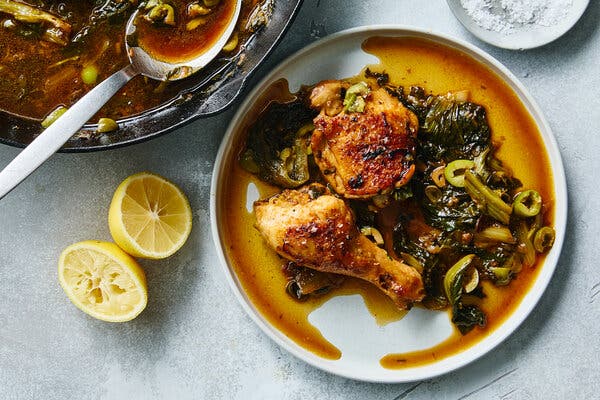Bone-in chicken on a bed of olive-studded, lemony greens is at the ready for sweater season.
Listen to this article · 2:22 min Learn more
Recipe naming conventions come and go. For the baroque excess of every Beany Leeky Greens with Greeky Rampy Beans, there’s a minimalist roast chicken or tomato salad to remind us that less is often very much enough.
Even techniques have aliases. One cook’s chicken fricassee is another’s braise, and yet another’s chicken stew. But all refer to the same bird browned in a pan and simmered in liquid with vegetables, until the meat is supple and soft, the vegetables succulent and the liquid fragrant.
Recipe: Skillet-Braised Chicken with Greens and Olives
I call my latest recipe Skillet-Braised Chicken with Greens and Olives because it’s direct, and to me the name evokes the poetry of the technique itself. The word “braise” always conjures a bubbling pot on a crisp evening, with a brawny, oniony cloud cloistering the kitchen from the chill nip outside. Actual cold weather may be weeks in the future, but my appetite is ready.
The rule of almost every chicken braise is to sear the meat first. This allows the skin to crisp and the fat to render, leaving behind those all-important brown bits at the bottom of the pan that provide the foundation of the sauce.
Liquid is added next, and that should be flavorful, too. The great James Beard suggested spiking plain water with a veal knuckle or pig’s foot, but he conceded that a good stock also works. I opt for stock because it’s easy and gives the right flavor to the greens, which get exquisitely silky after simmering for the half-hour or so it takes the chicken to cook.
Bone-in thighs and legs work best here because they’re forgiving: Cook them a little less, and the meat is taut and pleasingly springy; cook them longer, and it falls off the bone. You can use bone-in breasts instead, but watch carefully and take them off the heat as soon as they’re done. Their window of perfection is narrower, and you don’t want to overcook them.
Then to finish the dish, I top the rich chicken and soft greens with olives and lemon for contrasting brightness and tang.
I suppose you could call this a one-pan meal or skillet dish, since it’s cooked in a skillet. Name it whatever you like — everybody wins when dinner is served.
Melissa Clark has been writing her column, A Good Appetite, for The Times’s Food section since 2007. She creates recipes for New York Times Cooking, makes videos and reports on food trends. She is the author of 45 cookbooks, and counting. More about Melissa Clark
1
